Last Updated on: February 5, 2025
Massachusetts boasts over 500 species of birds.
It is a guarantee that you will always see a dozen or so species when bird watching at home or in a park.
Unfortunately…
We will not list all of them in this article. However, we will try to mention species from different genera to give you 30 popular birds of Massachusetts.
Of course, we cannot miss some species on this list because they are regular visitors to bird feeders. Read on to see what bird watching in this state entails.
30 Common Birds In Massachusetts
Which species are on your must-see list?
This state has some species only found in eastern states. Find out which ones they are below:
1. Song Sparrow

A few characteristics help you differentiate a song sparrow from other birds. For example, it has a rusty brown body and brown streaks on the chest that converge on the breast. When bird watching, you will see gray and brown stripes on a sparrow’s face. They make it look like it has gray eyebrows and cheeks.
Song sparrows are small birds averaging 4.7 to 6.7 inches long from bill to tail, and they love bird feeders with sunflower seeds or rice.
2. American Goldfinch

If you want to see some colorful birds in Massachusetts, search for American goldfinches. Summer birds have different plumage from the ones in winter. The summer bird has a bright yellow body and black feathers on the cap and wings.
However, the females have a dull yellow body without a black cap. The winter birds have brown-olive feathers and white bars contrasting their black wings.
Massachusetts is within the resident range of the American goldfinch.
The wintering range is in the southern states, while the breeding range is in the northern parts of North America.
You can set up bird feeders for these small birds so that larger backyard birds cannot intimidate them.
An American goldfinch eats thistle, aster, and grass. If your backyard lacks such plants, offer sunflower seeds.
3. American Crow
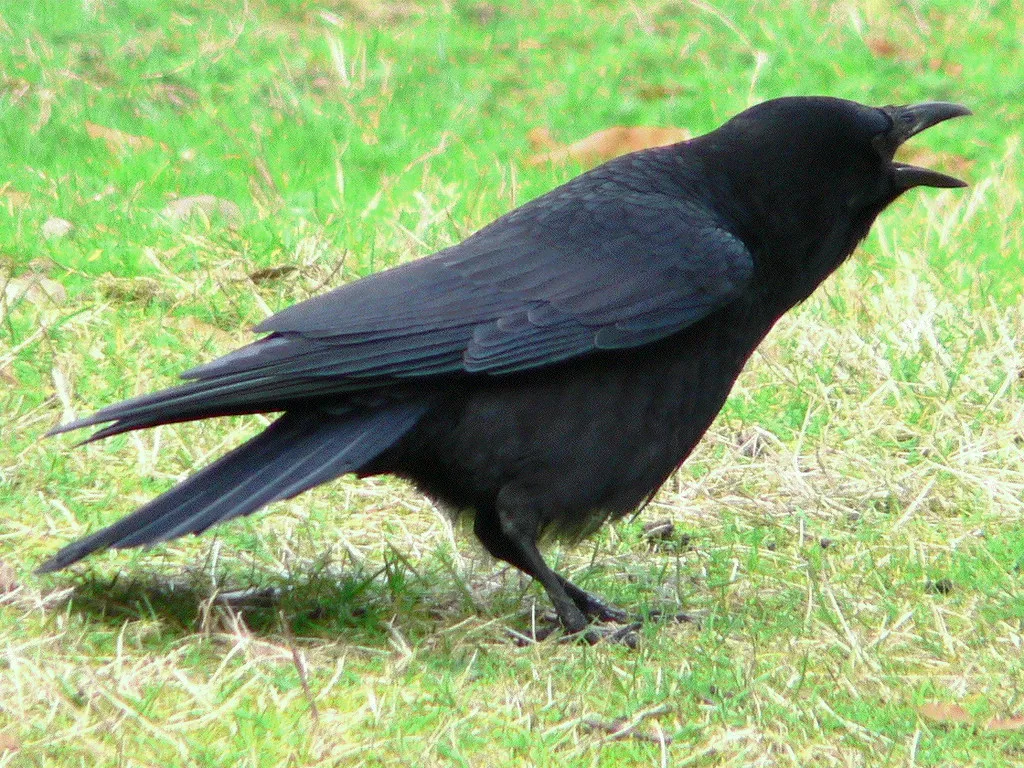
It has a black bill, legs, and feet. You might think it has a black body until you go closer to it and see the iridescent sheen. American crows visit backyards, but when they do, they come to scavenge in the garbage or eat bird eggs.
They inhabit woodlands, marshes, cemeteries, and farms. This species has a resident population in all Eastern states and breeding grounds in the northern area of North America.
4. House Sparrow

Remember how we said sparrows give you a hard time identifying them? For a house sparrow, look for a black bib on the male bird to differentiate it from the female. Additionally, a male has a black throat and a black line across the eye, whereas a female bird has a tan line.
Something else to help you differentiate the sexes is that male house sparrows have gray crowns, white cheeks, and brown backs with black streaks. Female sparrows have a dull brown body with black-streaked backs.
House sparrows have a resident population throughout North America except in the northern area, which has a scarce population. Therefore, you will see it throughout the year when bird watching in Massachusetts.
5. American Robin
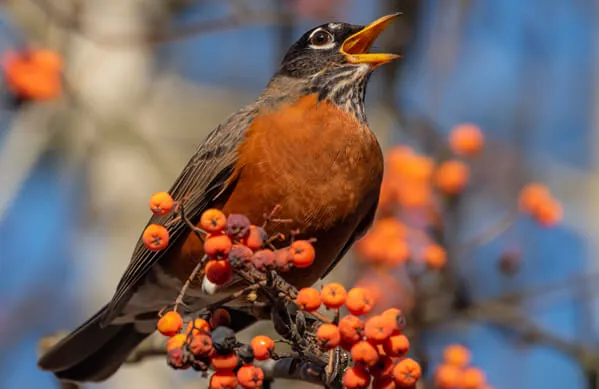
American robins are everywhere you turn because they live in so many habitats. They are in almost all of the United States except for the southern areas of Florida, California, and Texas that host wintering birds. Canada and Antarctica serve as breeding grounds.
When you explore these areas, you find the American robin eating invertebrates like worms and snails. It also eats fruits.
Look for a stunning thrush with a white throat, a bright yellow bill, white marks around the eyes, a dark back, and a rusty red underbelly. Body length from bill to tail is 7.9 to 11 inches. Both male and female American robins have the same plumage; however, the female is pale. This bird builds a cup-shaped nest and lays between three and five blue eggs.
6. House Finch

A rosy red head and chest differentiate a male house finch from a female because both sexes have brown streaks. A house finch is about the size of a house sparrow as it ranges between 5 and 5.5 inches long.
Since house finches are common in the neighborhood, there is no need to go bird-watching in a forest. Their population in North America is in the east and western states of the U.S. except the middle states.
House finches are curious, and they visit bird feeders offering sunflower seeds, safflower, or nyjer.
7. White-breasted Nuthatch

When two white-breasted nuthatches come to your bird feeders, you can differentiate a male from a female by the crown because a male has a black one while a female has a blue-gray one. This plump bird has a short tail, a long bill, a white chest, and a blue-gray back.
White-breasted nuthatches visit bird feeders to enjoy suet, safflower, or sunflower seeds. In the wild, you find them in cemeteries or wooded areas.
North America hosts resident birds except for Florida and the southern part of Texas.
8. Red-winged Blackbird

It is different from an American crow because male birds have orange shoulder patches. A female red-winged blackbird has heavy streaks instead of black plumage. You are likely to see these species perched on a fence post overlooking the land.
Red-winged blackbirds are in Massachusetts and most of the U.S. except parts of California and Arizona, where the birds winter.
The red-winged blackbird is very aggressive when protecting its nest. During the non-breeding season, you find this bird in grasslands or farms looking for weed seeds. It mingles with other birds like grackles and starlings to form a large flock.
9. European Starling

The starling is one of the most common birds in Massachusetts because it has a large population throughout North America. In summer, the birds have a black body with a greenish-purple sheen, which changes to a dark body with white spots in winter.
After their introduction to the U.S. in the 1890s, European starlings outgrew their first habitat, Central Park in New York, to spread throughout all states. The only problem is they are very aggressive and sometimes chase away native birds.
10. Downy Woodpecker

The downy is one of the common birds in Massachusetts and one you will see throughout North America. However, there are no downy woodpeckers in the southeastern states like California, part of Texas, and Arizona. It is easy to tell the male and female birds apart because the male has a red nape.
Both sexes have white bellies and black backs with white spots. Downy woodpeckers love a bird feeder with sunflower seeds, suet, and peanuts. They also visit hummingbird feeders for nectar.
11. Brown-headed Cowbird
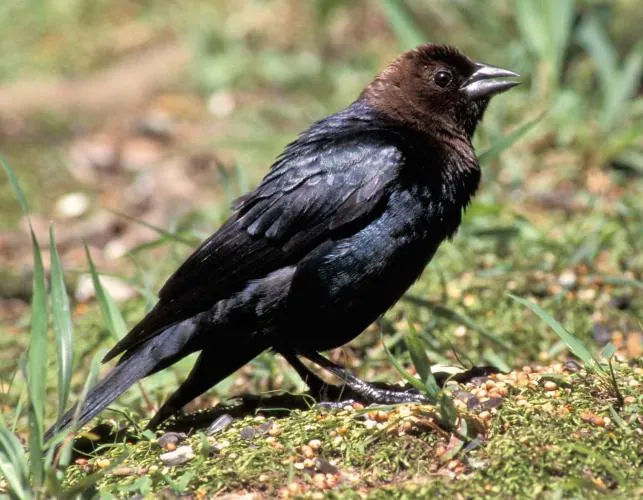
The male and female birds are slightly different as the male has a brown head while the female has a male brown body with some streaks on the belly. These stocky birds have thick bills. They inhabit Massachusetts and neighboring states as the breeding range is on the other side, in the western states.
Brown-headed cowbirds live in grasslands, the edges of woodlands, and thickets. Other species are wary of the brown-headed cowbird because this brood parasite lays eggs in the nest of other birds.
12. House Wren

A house wren is a small bird with a brown body, a short tail, and dark bars on its wings and tail. Male and female wrens have the same color pattern. The resident population is along the Gulf Coast. Most of North America is in the breeding range, including Massachusetts.
House wrens rarely come to a bird feeder. Brush piles can draw more birds to your backyard.
13. Hairy Woodpecker

The male has a red nape like that of a downy woodpecker, a feature that differentiates it from the female bird. If you want to tell hairy and downy woodpeckers apart, compare the bill because that of a hairy woodpecker is longer.
The hairy woodpecker is widespread in North America, except for some parts in the southeastern side, such as Arizona and Texas.
Hairy woodpeckers love mature forests, swamps, cemeteries, and bird feeders.
14. Mourning Dove

Both sexes of mourning doves have black spots on their grayish bodies, blue eye-rings, pinkish legs, and black bills. This dove is almost everywhere in Massachusetts, so you are probably already feeding these common backyard birds.
The only place without a resident population in North America is the breeding ground in the northern region and the wintering range in a few places south. The mourning dove loves safflower, cracked corn, shelled sunflower seeds, and millet.
15. Common Grackle

The common grackle is a large bird with a long tail and a long bill that curves downward. Both sexes have bronze bodies and iridescent blue heads though females are not glossy.
Common grackles breed in Canada and some middle states in the U.S. The resident population is in the eastern states, and Massachusetts is one of them.
These birds eat insects, fruits, mice, and other birds. They also love grains and frequent farms looking for some. This diverse diet makes them survive in any backyard, no matter how much you try chasing them away because they are aggressive and scare the smaller species.
16. Black-capped Chickadee

If you are looking for photogenic birds in Massachusetts, make sure the black-capped chickadee is on your list. This small, stunning bird has a large head, gray wings, black cap, black bib, and a whitish underbelly. It is about half the size of an American robin as a black-capped chickadee has a body length between 4.7 and 5.9 inches.
As for habitat choices, the black-capped chickadee loves open deciduous forests, and you can also find it in cottonwood groves. Plus, black-capped chickadees visit bird feeders to sample sunflower seeds, suet, and peanuts.
The black-capped chickadee is only in northern Massachusetts.
17. Eastern Bluebird
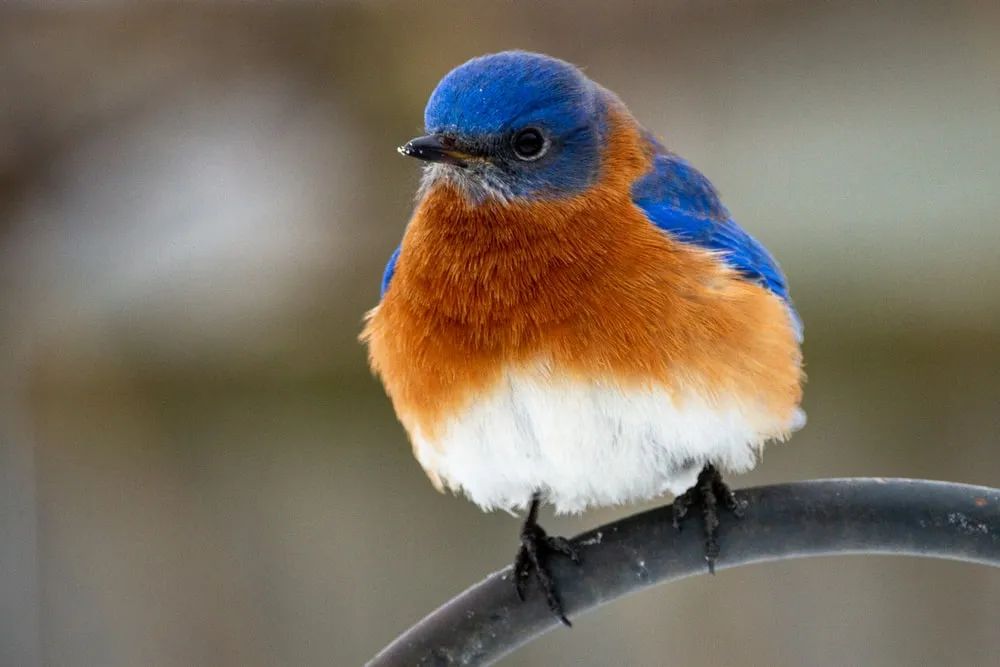
These bluebirds flaunt a blue back, rusty throat, and a whitish underbelly. You can draw them to your bird feeder with mealworms or bellies. If you prefer to see them in the wild, look for them in cemeteries, farm fields, and meadows.
Most homeowners set up birdhouses for the Eastern bluebird as it is smallish, between 6.3 and 8.3 inches long.
18. Northern Cardinal
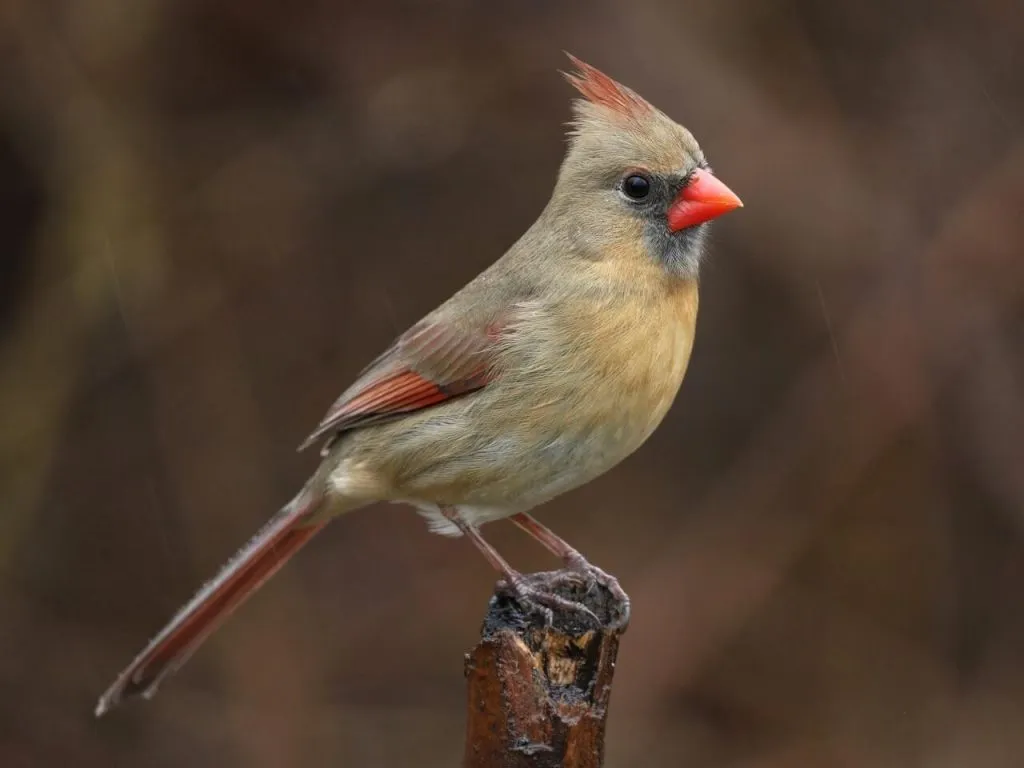
We have not talked about backyard birds in Massachusetts that feed on the ground, so here is one of them. The northern cardinal prefers to crack seeds on a tray or hopper feeder with its thick bill. You can offer sunflower, safflower, peanuts, or corn.
You know northern cardinals for their stunning red bodies with black masks and throats. That is what you should expect of the male cardinal as the female has an orange-brown body and red tinges on its crest, wings, and tail. It grows between 8.3 and 9.1 inches long; therefore, it is smaller than an American robin.
The resident avians inhabit the western and southern states. It is one of the avians not found in western states.
19. Ruby-throated Hummingbird

Onto another beautiful bird, although this one has a colorful throat instead of a crest. A male ruby-throated hummingbird has a sharply pointed bill, gray underparts, and greenish flanks.
Massachusetts is in the breeding range of ruby-throated hummingbirds, so they are abundant in the warm summer months before migrating to wintering grounds in Mexico.
20. Blue Jay

Blue jays stand out in a backyard because of their colorful blue bodies with black bars and white underbellies. Both sexes have a black necklace and a blue crest. They grow between 9.8 and 11.8 inches long, and despite their stunning bodies, these backyard birds have the worst personalities as they are very aggressive.
You can overlook that behavior to enjoy having them around because they are very intelligent to the point of mimicking the call of a hawk. There are jays in all eastern states throughout the year.
21. Dark-eyed Junco

Adult dark-eyed juncos have varying color patterns: some have dark slate gray plumage, the ones in the Rocky Mountains have pinkish flanks, while other western birds have a light-brown back and a dark-brown hood. Both sexes are between 5.5 and 6.3 inches long; therefore, they are a few inches longer than chipping sparrows.
Dark-eyed juncos are hoppers that forage fallen seeds on your lawn. They love coniferous and mixed forests and spend winter in open woodlands, roadsides, and fields. These backyard birds of Massachusetts are resident bird species in the north, whereas the rest of the state hosts wintering birds.
22. Rock Pigeon

Rock pigeons are adorable, plump birds. These backyard birds have a gray back, black wing bars, thin bills with a white stripe, short legs, and blue-gray heads. However, there are plumage differences, with some varieties displaying a white or rusty brown body.
Rock pigeons are everywhere in North America throughout the year except in the northernmost parts. Consequently, expect flocks of rock pigeons in your backyard wherever you have bird seed or leftovers from your kitchen. They become a nuisance when they show up in large numbers.
23. Pileated Woodpecker

It is rarer than the downy and hairy woodpeckers. They are not even in all of Massachusetts, as you can only see them in the western region. They are crested birds like some of the other species we mentioned earlier.
Do you remember any crested birds talked about in this article? A pileated woodpecker has a black body and white stripes across its face and neck. A male has a red strike on the cheek that matches the red crest, whereas a female pileated woodpecker has a black stripe.
These woodpeckers eat ants and beetles extracted from rotting wood. Therefore, you can host this bird species on your lawn if there are dead trees.
24. Baltimore Oriole

Have you seen a bird with orange and black plumage before? Baltimore Orioles will have you looking at them for a few minutes to take in all their beauty. The male birds have orange bodies with white and black wing bars, while the females have duller bodies without a black hood.
There are no resident Baltimore orioles in North America, so the ones in Massachusetts are breeding birds.
They come to bird feeders for fruits, nectar, and jelly, but you can look for them in the wild. In that case, look for them in open woodlands, swamps, or riverbanks. They stay in forest edges instead of deep forests.
25. Tufted Titmouse

The tufted titmouse is another crested bird like the northern cardinal or the blue jay. However, this one flaunts a bluish-gray crest. It has peach flanks and white underparts, and it is a small bird between 5.5 and 6.3 inches long from the bill to its tail.
Add it to the list of birds of Massachusetts that you have to see because its population is only in the eastern states, and luckily, these are all resident birds that you can see any time of the year.
As you explore deciduous forests or watch birds in your backyard, look for one that loves hanging upside down or sideways as it performs stunning acrobatic moves. And also, the Tufted titmice love safflower seeds, suet, and peanuts.
The only problem is the tufted titmouse is a shy bird, so you may not see it for long before it flies away after picking seeds from your feeder.
26. Gray Catbird

This robin-sized bird can grow between 8.3 and 9.4 inches long. Its dark gray body might not be as outstanding as an American goldfinch or Baltimore oriole, but a gray catbird is just as stunning to capture on your camera when bird watching. Listen for a bird that sounds like a cat when exploring fruit-bearing trees.
Massachusetts is one of the few states with a resident population of gray catbirds as they inhabit the Atlantic coast all year round. The Gulf Coast, the Caribbean, and Central America host wintering birds.
The gray catbird can visit your backyard if there are native fruit trees like serviceberry and dogwood.
27. Red-bellied Woodpecker

They are as stunning as the American goldfinches or the blue jays but in different plumage colors. Red-bellied woodpeckers have black and white bars on the back, a red crown on the male, and a red nape on the female. They are only in the eastern states, which includes Massachusetts. You can see them in the southern area of this state.
28. Red-eyed Vireo

This long-distance migrant flies from breeding grounds throughout east and northeast North America to winter in South America.
One thing to love about red-eyed vireos is their mastery of songs. A male can sing over 20,000 songs in a day.
This tiny bird is 4.7 to 5.1 inches long; thus, it is smaller than a tufted titmouse.bIts colorful pattern consists of an olive-green back, a white underside, a gray crown, and a white eyebrow. A red-eyed vireo also has green-yellow flanks and red eyes seen up close.
Look for red-eyed vireos in the eastern forests in summer, where they enjoy caterpillars from treetops.
29. Northern Mockingbird

The flock of medium-sized birds keeping you awake is probably northern mockingbirds, as they are common birds of Massachusetts. They sing a string of about 15 songs day or night. It is interesting to watch the 8.3 to 10.2 inches-sized birds defending their territory from intruders because they are outstanding despite their size.
Fruits trees like hawthorns and mulberries attract northern mockingbirds to your backyard.
You can tell a northern mockingbird by its gray-brown body and pale underbelly. It also has white wing flashes as it flies and wing bars of the same color.
30. Carolina Wren

These might be the only birds on our list that will have you waiting for the longest time to spot them as they are shy. However, you will find Carolina wrens when you follow the teakettle-teakettle song you hear in a wooded area.
They also visit backyards in winter for suet or to stay in your nest boxes.
These backyard birds have a reddish-brown back with dark bars on the wings and the tail, a white throat, and a buffy underbelly. Their average body length is 4.7 to 5.5 inches, so they are larger than house wrens.
Which of these birds have you spotted so far?
Roaming Tip: How does traveling to a laid-back state sound to you? Fly with us as we show you around through our article here — Birds In Alabama.
Watch This!
Frequently Asked Questions
What are the little brown birds in Massachusetts?
You are probably talking about Carolina wrens because they are small, brown avians seen everywhere in this state. The other likely bird species is the house wren, almost the size of Carolina wrens, but it is migratory.
What is the most common bird in New England?
Many bird species are common in these states, in different habitats. For instance, you will see American crows, house sparrows, European starlings, and rock doves in urban centers.
However, in parks and suburbs, there are more backyard birds like blue jays, gray catbirds, red-winged blackbirds, and cedar waxwings. Shoreline birds include the piping plover, herring gull, and the double-crested cormorant.
What birds are common in Boston?
There are many common species, including the red-tailed hawk, blue jay, rock pigeon, herring gull, and peregrine falcon.
Conclusion
One of the best ways to learn about the local birding scene is by participating in meetups and workshops organized by birders in Massachusetts. You discover bird-watching locations like Fort Hill, Salisbury Beach State Reserve, and the Great Meadows Wildlife Refuge.
Additionally, you learn about rare sightings and the best ways to attract more backyard birds. In a state with over 500 species, you have a lot to experience.

